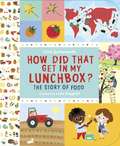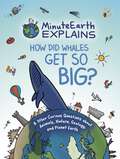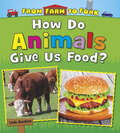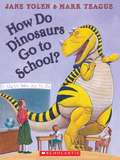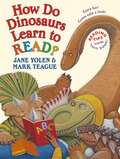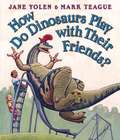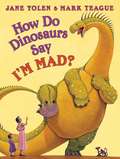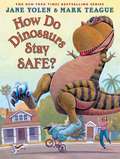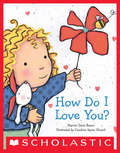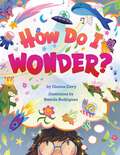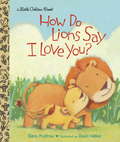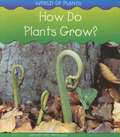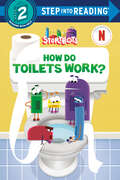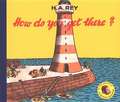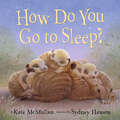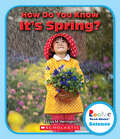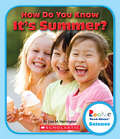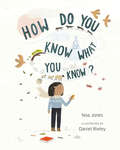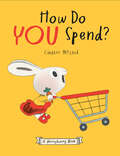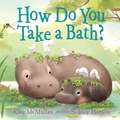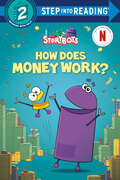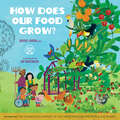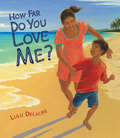- Table View
- List View
How Did That Get in My Lunchbox? The Story of Food
by Chris ButterworthFresh retro artwork lures little readers on a tasty trip to farms, dairies, and more. Yum! The best part of a young child's day is often opening a lunchbox and diving in. But how did all that delicious food get there? Who made the bread for the sandwich? What about the cheese inside? Who plucked the fruit? And where did the chocolate in that cookie get its start? From planting wheat to mixing flour into dough, climbing trees to machine-squeezing fruit, picking cocoa pods to stirring a vat of melted bliss, here is a clear, engaging look at the steps involved in producing some common foods. Healthy tips and a peek at basic food groups complete the menu.
How Did Whales Get So Big?: & Other Curious Questions about Animals, Nature, Geology, and Planet Earth (MinuteEarth Explains)
by MinuteEarthSTEM for Kids ― Fun for Kids (Ages 8-10)#1 New Release in Children's Books: Environment & Ecology, Atlases, Anatomy, and Earthquake & VolcanoIn their debut illustrated science book for kids, the team behind the popular YouTube channel MinuteEarth answers all of your child’s wackiest questions about animals, nature, and science alongside engaging images of the natural world.From the scientists, writers, and illustrators at MinuteEarth. Have you ever wondered where Earth’s water came from? Or why leaves change color in the fall? Entertain and educate your kids with fun facts about animals, nature and the wonders of the earth.Amazing STEM for kids, explained simply. With over 300 million views, MinuteEarth simplifies such serious subjects as geology, ecology and biology making them fun for kids. Featuring their signature puns and fun illustrations, this first book in the MinuteEarth Explains series explores topics ranging from weird animal facts to extreme weather, making science for kids enjoyable and unforgettable.Curious questions about our awesome planet. Whether your child is obsessed with the wonder of nature, can’t learn enough interesting facts about animals, or is fascinated by volcanoes, MinuteEarth Explains captures their imagination and fosters an interest in animals, the Earth, and ocean life! By combining humor with rigorous research, this book provides fun facts about animals, nature, science and more in an equally engaging and informative way for kids.MinuteEarth Explains captivates kids with answers to:Why do some animals get gigantic?Why do rivers curve?Can plants talk?How much food is there on earth?And more!If you’re looking for nature books for kids (8-10) or earth science books for kids―or if your child loves books such as The Big Book of Birds, Why?: 1,111 Answers to Everything, or The Wondrous Workings of Planet Earth―then your whole family will love this debut book by MinuteEarth!
How Do Animals Give Us Food? (From Farm To Fork: Where Does My Food Come From? Ser.)
by Linda StanifordThis fascinating book looks at how animals give us food, taking the beef we eat as an example. Engaging text and beautiful, color illustration show readers how beef is produced, processed, and packed through its long journey to end up on our plates.
How Do Dinosaurs Go to School? (Elementary Core Reading Ser.)
by Jane Yolen Mark TeagueNIMAC-sourced textbook <P><P>School has never been so much fun! Come along for a very unusual day and laugh out loud as the dinosaurs enjoy story time, show-and-tell and recess.
How Do Dinosaurs Learn to Read
by Jane YolenAmerica's favorite dinosaurs romp and roar as they soak books in the bathtub, throw them, and finally learn how to carefully read them... with Mama and Papa at bedtime. Get ready to laugh at this lighthearted, heartwarming, and funny approach to books! Children sometimes feel the task of learning to read is overwhelming, but the winning combination of rhyme and illustrations here provide a perfect way to present the subject in a comical, engaging, and nonjudgmental way. The contrast of enormous dinosaurs in kid-sized bedrooms (with human parents) adds irresistible humor as families explore the do's and don'ts of reading. Both practical and engaging, this book shows dinosaurs getting into all sorts of reading-related trouble! But of course, in the end, the dinosaurs learn how to carefully handle their books, read out loud, and read a lot!
How Do Dinosaurs Play with Their Friends?
by Jane Yolen Mark TeagueCome along for some BIG fun as your favorite dinosaurs delight young readers with their playful antics.
How Do Dinosaurs Say Im Mad
by Jane YolenSome of them count to ten, some of them have a time out, and some of them take deep breaths. Then, when the dinosaurs are calm again, they clean up any mess they've made, they say, "I'm sorry," and they give big hugs. Just as you do.
How Do Dinosaurs Stay Safe?
by Jane YolenFrom crossing the street with Mama to encountering a stranger, the playful but careful antics of America's favorite dinosaurs will make readers laugh aloud -- and prompt discussion of safety issues. Few things in childhood are as important as learning how to behave safely, and the topic deserves discussion in every family. Now Jane Yolen and Mark Teague deftly approach this critical subject with warmth, humor, and hilarity. The wildly funny contrast between Teague's massive dinosaur children and their human-sized surroundings makes this subject especially appealing and funny. Where a book about safety for children might be potentially frightening, the antics of immense dinosaurs jumping on the bed or learning how to dial 9-1-1 on Mama's tiny phone will keep readers laughing from start to finish. Parents, children, teachers, and other caregivers need a comfortable way to discuss safety, and this book provides just that. And as children learn invaluable rules about safe behavior, they'll beg to read it again and again for the wildly appealing silliness on each page. Here is a book that belongs in every household!
How Do I Love You?
by Marion Dane BauerA rhyming story about a parent's unlimited love for a child -- in the same format as the bestselling book I Love You Through and Through, and with pictures by the same illustrator."How do I love you? Let me count the ways.I love you as the sun loves the bright blue days . . ."In this padded board book, a parent declares her love...as the bees love a flower, a duck loves a shower, a bird loves to sing, a bear loves the spring. Written by Newbery-award-winning author Marion Dane Bauer, inspired by the poem by Elizabeth Barrett Browning, and with pictures by Caroline Jayne Church, illustrator of the bestselling I Love You Through and Through.
How Do I Wonder?
by Gianna DavyThrough lyrical text and vivid images, How Do I Wonder? invites young readers to open the door to their miraculous minds, exploring the wacky and wonderful 'What-ifs' and 'Whys' of the world around—and within—them."A thought-provoking tale with a much-needed message: The mind is a place of limitless wonders."—Kirkus Reviews A book can be a powerful tool to spark creativity and imagination. Do snails view turtles as slow? Why is water wet? From the author of No One Owns the Colors comes an entertaining and beautifully illustrated picture book that shows children how to ask questions that help them see the world in a different way. Written and illustrated for all children, each page showcases a diverse and engaging world and helps kids ages 4-8 develop a growth mindset. Let the silly prompts show how the joy of a simple question can entertain the mind and spirit, no matter where you happen to be. • Curriculum Connection—Creative prompts help open up pathways to discovery and spark a catalyst to classroom engagement. • Infinite Curiosity—Teach the innate sense of wonder that demonstrates joy is everywhere, not just in a certain place. • Evocative Words—The lyrical text is entertaining to read and the vivid imagery helps keep the curiosity in children flowing. Start helping your little ones see the world in a new way with How Do I Wonder?
How Do Lions Say I Love You? (Little Golden Book)
by Diane MuldrowLions say "I love you" with a purr and a cuddle.Wolves say "I love you" with a howl and a huddle.Bears like to say it with a kiss on the muzzle.A mama cow says it with a lick and a nuzzle. . . .Sweet, simple rhymes and glowing illustrations in soft pastels show the touching ways that animals--from elephants to giraffes to chickens--bond with their families.
How Do Plants Grow? (World Of Plants Ser.)
by Louise Spilsbury Richard SpilsburyLooking inside a seed. We'll look at a cut-open bean seed and talk about the food store and the baby plant and the seed coat. The baby plant in a seed stays safe and warm inside the seed coat until it is ready to start growing, usually in spring when the weather is warm and wet.
How Do Toilets Work? (Step into Reading)
by Random HouseThe robots from Netflix's Ask the StoryBots star in an all-new Step 2 Step into Reading leveled reader about how toilets work.We use the toilet every day, but how does it work—and where does our waste go? Join the StoryBots for an amazing adventure into the toilet, through the plumbing, and beyond. What they learn will fascinate children ages 4 to 6 who love Netflix's educational show.Step 2 Readers use basic vocabulary and short sentences to tell simple stories. For children who recognize familiar words and can sound out new words with help. Check out the other book in the series:Tyrannosaurus RexTriceratopsVelociraptorsThe Moon&’s Turn to ShineStop That Virus!
How Do You Get There?
by H. A. ReyIn How Do You Get There? children guess the means of transportation to be used.
How Do You Go to Sleep?
by Kate McMullanDiscover how different animals go to sleep in this rhyming picture book from a veteran children's author! Follow along as three children learn about the bedtime routines of squirrels, parrots, dolphins, and many more. Meerkats sleep in a stack. Is that how these kids go to sleep? Or do they hibernate in snow all winter long like frogs? Or maybe they sleep the day away like skunks? No, that can't be right! By the book's conclusion, the kids have imitated all kinds of animals who are portrayed sleeping in their natural habitats, thanks to Sydney Hanson's charming illustrations. Readers will recognize the way the human child eventually goes to sleep--with stuffed animals, a bedtime story, and a kiss good night!A Bank Street Best Book of the Year "Punctuated with zaniness, McMullan's litany nevertheless offers a quiet, calming rhythm to help little ones nod off."--Kirkus"A bedtime book that will soothe and please children and caregivers."--SLJ"A nice pairing with Diane Muldrow's How Do Giraffes Take Naps?, Vin Vogel's Bedtime for Yeti, or Cari Best&’s I&’m Brave! I&’m Strong! I&’m Five!, particularly for little ones looking for comfort around sleeping in their own beds."--Booklist
How Do You Know What You Know?
by Noa JonesA charming and inquisitive story that celebrates tracing the origin of ideas, language, and every day objects, for children 4–8.Where does snow come from? What language did the word thermos come from? And who was the Buddha's teacher?So many problems in the world come from accepting information at face value without looking into where it comes from. How Do You Know What You Know? follows a child and their father on a cozy, snowy day outing. The child asks questions about how things came to be the way they are. The questions range from how the father knows how to tie a shoe to why it&’s not a good idea to eat yellow snow. These queries are met by the father with patience and humor that weave a delightful narrative of intergenerational knowledge sharing. In this exchange, respectful inquiry is beautifully modeled for young learners.The journey includes an amble in the park, a trip to the library, a bus ride, and a visit to a local Buddhist temple where the father is a student. The teacher there introduces the child to the idea of lineage, that wisdom and understanding comes from generations of knowledge passed down from person to person. With a quaint and welcoming simplicity, the illustrations bring this beautiful story to life, and every spread has a subtle nod to the progression of how things come to be the way they are. The story encourages children&’s natural curiosity and shows them that everywhere they look there is a story to be told if we just ask.
How Do You Spend? A Moneybunny Book (A Moneybunny Book)
by Cinders McLeodCelebrate the many different ways a little bunny can spend her savings, and learn about opposites too!Bun has been saving her carrots, and now it&’s time to spend some—but HOW will she spend them? Well, she could spend fast and buy a lot of things all at once, or she could take her time and spend slowly on something unique. She could buy something ordinary like a toothbrush, or something exciting like a mini sports car. Then there are things to buy for herself and things to buy for others, as well as things she needs and some that she wants. There are so many options, and little bunnies will have a ball considering them all!
How Do You Take a Bath?
by Kate McMullanPerfect for fans of Five Little Monkeys Jump in the Bath, this fun and educational picture book brings together adorable baby animals and bathtime.How do YOU take a bath? Does your mama comb your fur?Do you shake off all your dirt?Do you splash and flap and quack?Do the birdies peck your back?No!Follow elephants, pigs, monkeys, hippos, and more in this charming rhyming picture book from veteran author Kate McMullan. How does a pig take a bath? It sinks in the mud! What about a chicken? It thrashes about in dust! And a cat? Why, it licks itself clean, of course! Sydney Hanson's adorable illustrations toggle neatly between animals in nature grooming themselves and humorous depictions of children attempting the animals' bathing tactics. By the end of the book, the child finally makes his way to the bathtub, no mud baths or lick baths about it!
How Does Money Work? (Step into Reading)
by Scott EmmonsThe robots from Netflix's StoryBots Answer Time star in an all-new Step 2 Step into Reading leveled reader!Bing wants to know what money is and why we use it. His questions lead him from a bank to a tour of a successful lemonade stand. What he learns will fascinate children ages 4 to 6 who love Netflix's educational show.Step 2 Readers use basic vocabulary and short sentences to tell simple stories. For children who recognize familiar words and can sound out new words with help.
How Does Our Food Grow
by Brooke JordenFruits and vegetables all taste great, but how did they end up on your plate? The fresh and colorful foods you know came from farms—that&’s where they grow! Some grow underground and some hang from trees. Can you find them all? Let&’s look and see! Every fruit, vegetable, grain, and legume has its own story: Where do they grow? How do they taste? And how do they impact our bodies and the world around us? In cooperation with Kitchen Connection, an organization committed to improving our food system through education, this colorful picture book introduces readers to the concepts of biodiversity, reducing food waste, and proper growing conditions for different crops in simple, accessible language. With cool facts and challenges throughout, fun rhyming verse, and charming illustrations, How Does Our Food Grow? tells the stories of more than a dozen of your favorite fresh foods. Knowing that our food choices make a difference in our health and the health of our planet empowers us to choose wisely. The more we know, the better we grow.
How Does a Tree Help? (Into Reading, Level B)
by David Bauer<p>NIMAC-sourced textbook <p>All kinds of animals make their homes in trees. Children do, too!</p>
How Far Do You Love Me?
by Lulu DelacreThis unique bedtime book by award-winning author-illustrator Lulu Delacre features a game that highlights the universal love between caregivers and children while taking readers on a journey across the seven continents of Earth.How far do you love me?I love you to the top of the peakslit by the morning sun ...To the crests of the desert where the wind sweeps sand from the dunes ... Based on a bedtime game that author-illustrator Lulu Delacre played with her young daughters, How Far Do You Love Me? is an "I love you" book with a twist. With every expression of love, readers visit a different location around the world, each a beautifully illustrated scene of caregivers and children in a place of natural beauty. The intimate size of the book is just right for sharing and snuggling up close with a child. As bedtime--or any quiet time--approaches, gather close with a special person in your life and get ready to let your imagination soar to place after place as you embark on a game of "How far do you love me?" The possibilities are endless!
How Garbage Gets from Trash Cans to Landfills (Here To There Ser.)
by Erika L. Shoresrecycling; homes; utilities; community helpers; garbage collectors; garbage trucks
